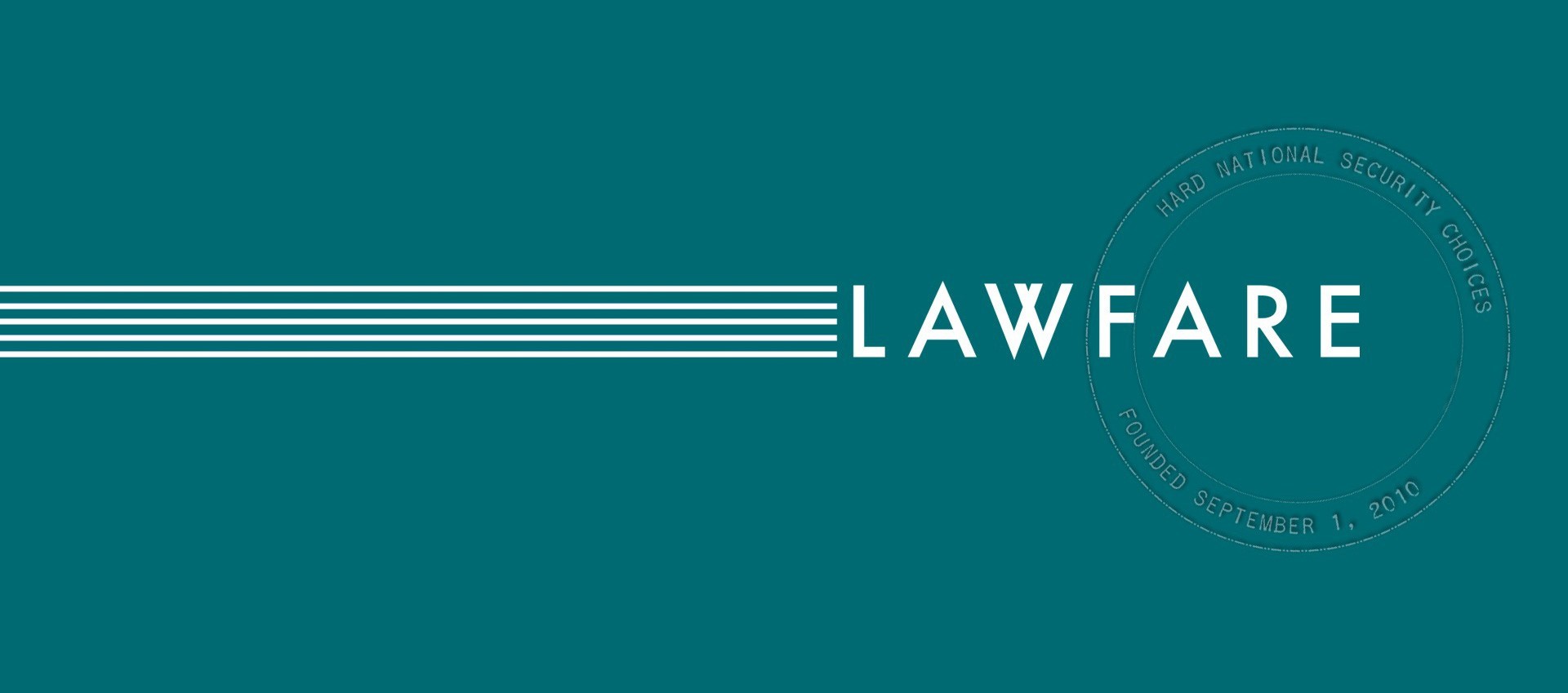How, and How Often, Do Legal Academics Use FOIA?
Since its enactment in 1966, the Freedom of Information Act (FOIA) has served as a significant source of transparency in government, allowing anyone to access official records that would otherwise be unavailable to the public. Legal academics have analyzed the statute in numerous law review articles, most of which seem to embrace FOIA’s underlying goals. Yet the actual use of FOIA and its state-law equivalents in legal academia has been quite limited.
Published by The Lawfare Institute
in Cooperation With

Since its enactment in 1966, the Freedom of Information Act (FOIA) has served as a significant source of transparency in government, allowing anyone to access official records that would otherwise be unavailable to the public. Legal academics have analyzed the statute in numerous law review articles, most of which seem to embrace FOIA’s underlying goals. Yet the actual use of FOIA and its state-law equivalents in legal academia has been quite limited. By my count, fewer than 60 law review articles in the entire Westlaw database report that the author obtained or tried to obtain records under a freedom-of-information law in carrying out the underlying research. In other words, law professors generally embrace transparency—but have traditionally relied upon others to supply it.
Data suggest that trend is now changing: As far as I can tell, no law review articles reported engaging in research using FOIA prior to 1994, and no more than three did so in any given year from 1994 to 2011, but slightly higher numbers have appeared virtually every year since. In addition, more research is on the way: Yale Law School’s Center for Global Legal Challenges, for example, has been litigating a request for records specifying the sources of domestic legal authority for the numerous international agreements, other than Article II treaties, to which the United States is a party. Jean Galbraith and Benjamin Schwartz are using FOIA to gather Justice Department views letters. As I explained in a recent post, I’ve had a FOIA project of my own. And as readers well know, Lawfare editors and contributors have pursued an important collection of other law-relevant FOIA inquiries in the past 18 months.

Figure 1: The Use of FOIA in Legal Scholarship
Though still quite modest, the rise of FOIA-based research in legal scholarship and commentary strikes me as a positive development, for two reasons. First, law professors are well positioned to deliver the sort of civic-minded transparency that FOIA makes possible: Given the slow pace of most academic research, legal academics can often afford to wait for a government response for months or even years. Under the federal FOIA, they will generally qualify for a fee waiver. Given legal training, they should be relatively skilled not only at identifying promising leads on records of interest but also at ascertaining the merits of a potential FOIA request and navigating the administrative process. And they have strong incentives to disseminate findings.
Second, it’s easy to imagine an abundance of empirical and doctrinal payoffs. To name just one example, constitutional scholars who embrace the historical-gloss approach to interpretation could file FOIA requests to obtain previously unavailable records on issues pertaining to the separation of powers, and then use those records to develop accounts of official practice that are much richer than the public sources alone would allow. More generally, FOIA-based research could help to narrow the gap between the law in theory and the law in practice. Recent reports of a decline in the use of FOIA among journalists and a persistent flood of requests from corporate actors who frequently hoard the results for private purposes suggest that FOIA-based academic work could be more important than ever.
True, this sort of activity is not cost-free. As David Pozen has argued, agency compliance with FOIA expends financial resources, diverts attention from other tasks, potentially deters candid deliberation by government employees and appears to foster unduly negative perceptions of the executive branch. In view of these effects, researchers will need to carefully consider whether a request will be worthwhile.
But let’s assume that at least some FOIA-based legal academic work warrants the public costs. How should one go about making a request? The federal process presents a number of hurdles that might catch first-time requesters by surprise and frustrate otherwise promising work. To help prevent problems that might arise, I’d like to share a few things I learned from my recent experience.
First, even if none of the statutory exemptions to disclosure apply, a federal agency will not necessarily have to produce all of the records covered by a request. Instead, as the U.S. Court of Appeals for the D.C. Circuit has explained, the agency must merely make a “good faith effort to conduct a search ... using methods which can be reasonably expected to produce the information requested,” and then hand over any nonexempt results. Under this standard, a search must be more than perfunctory, follow obvious leads and extend beyond a single record system if there are others that are likely to contain the requested information. At the same time, there’s simply no requirement for an agency to search every one of its systems, much less produce every extant, nonexempt record that falls within the scope of a request. As one court explained, the sufficiency of a search is determined not by the completeness of its fruits, but rather by “the appropriateness of the methods used to carry [it] out.” The result is that requesters—particularly those who seek a large volume of records—could very well end up with far less than desired.
At the same time, courts have suggested that a carefully worded request might improve the chances of a search that is both adequate in terms of methodology and satisfying to the requester in terms of yield. Some courts have hinted at the possibility that a requester could guide the agency’s search by specifying the anticipated location of the desired records in addition to dates and contents. Others have indicated that the odds of success will improve if the researcher formulates the request in a way that takes into account the organizational logic of the agency’s filing systems. In my own case, I simply asked for copies of “‘certificates of demonstrated competency’ for each ambassadorial nominee from January 1, 1980 to present” and then identified the specific statutory authority pursuant to which the State Department creates the certificates. In its initial responses, the department produced records for roughly 1,000 bilateral nominations, but this amounted to barely more than 60 percent of the approximately 1,600 nominations that occurred within the specified period. Conceivably, I could’ve facilitated a more fruitful search at the outset if I had drafted my request in light of any information on the State Department’s filing systems. That information can be difficult to obtain, but one potential solution would be to ask for it in a preliminary FOIA request, and then use the fruits of that request to draft a follow-on request for the documents that are directly relevant to one’s research. Of course, this approach would require a great deal of patience.
Second, it’s quite plausible that the agency will fail to conduct an adequate search even under the permissive standard set forth by the D.C. Circuit. A January 2016 report from the State Department’s Office of Inspector General notes that searches performed by the department’s Executive Secretariat, for example, “do not consistently meet statutory and regulatory requirements for completeness” and that “responses are sometimes inaccurate.” The initial search in my case, which did not involve the Executive Secretariat, was also inadequate, and a significant number of FOIA lawsuits appear to arise from the same problem.
Litigation is less than ideal, but it might be the only effective response. Of roughly 200 published federal judicial opinions on search adequacy from September 2014 to September 2017, roughly 31 percent came out against the agency. And it’s not uncommon for agencies to settle. In my case, the State Department settled by agreeing to produce additional records and then delivered them in a series of tranches over an eight-month period. In the end, I managed to collect virtually all of the records covered by my request.
Third, depending on the agency and the nature of a request, it could take years to obtain the results, regardless of search adequacy. Let’s say you seek a high volume of records from the State Department. In 2017, nearly 40 percent of those requests took over 200 days to process, and roughly 10 percent took more than 400 days. In my case, it took four years to reach a satisfactory outcome. This included two and a half years of waiting for the State Department to deliver the first half of the covered records, the expiration of five different estimated completion dates, and then roughly a year of litigation. Understandably, such delays, whether at the State Department or elsewhere, appear to have led a number of scholars simply to give up on FOIA—several explained in footnotes that the relevant agency had granted their request but then failed to produce any records in time for the article’s publication.
Fortunately, delays may be shrinking, at least at the State Department: In August 2016, the agency’s FOIA Requester Service Center explained to me that, since 2008, there had been a “300 percent increase in the number of FOIA and Privacy Act requests” received annually. But former Secretary of State Rex Tillerson made a major priority of reducing the resulting backlog of pending requests, and it appears that the effort has been at least partly successful. In view of this development, it seems plausible that future requesters will not have to wait as long.
Finally, if my case is indicative, an agency will not volunteer information on either its search methodology or the completeness or representativeness of the search results, even after processing a request. Upon delivering the first batch of records for my request, the State Department simply closed my case; it was only because I later filed suit for inadequate search that the agency eventually provided a description of its search methods. For those who seek only a small number of documents, this is not necessarily an issue. But it’s a significant problem for researchers who seek a large volume of records to generate findings that depend on the completeness or representativeness of the materials that the agency has delivered. One conceivable solution, other than litigation, is to file a FOIA request for a description of the search methodology, either separately from or as part of the request for the documents that you’ll use in the underlying research.
I don’t purport to be a FOIA expert. I don’t typically write about FOIA, and I’ve only ever litigated one FOIA case. I do, however, believe my experience is fairly indicative of problems that others encounter in pursuing FOIA-based research. I hope that my observations are useful as others use freedom-of-information laws to generate new scholarship.




